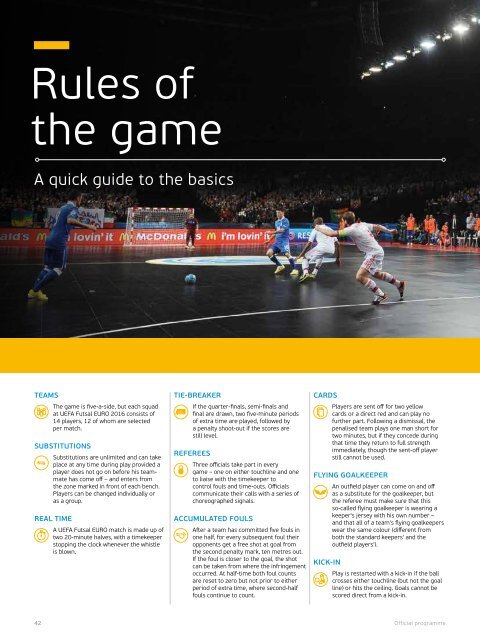SERBIA 2016
1nddoAk
1nddoAk
You also want an ePaper? Increase the reach of your titles
YUMPU automatically turns print PDFs into web optimized ePapers that Google loves.
Rules of<br />
the game<br />
A quick guide to the basics<br />
Italy push Russia back during the 2014 final in Antwerp<br />
TEAMS<br />
TIE-BREAKER<br />
If the quarter-finals, semi-finals and<br />
final are drawn, two five-minute periods<br />
of extra time are played, followed by<br />
a penalty shoot-out if the scores are<br />
still level.<br />
CARDS<br />
Players are sent off for two yellow<br />
cards or a direct red and can play no<br />
further part. Following a dismissal, the<br />
penalised team plays one man short for<br />
two minutes, but if they concede during<br />
that time they return to full strength<br />
immediately, though the sent-off player<br />
still cannot be used.<br />
RESTART<br />
Players have four seconds to restart play<br />
from a kick-in or free-kick. At set plays or<br />
when the keeper has the ball, the referee<br />
raises an arm and counts down with his<br />
fingers those four seconds.<br />
THE COURT<br />
The UEFA Futsal EURO court is 44.4m<br />
long and nearly 25m wide and is<br />
composed of 1,273 laminated black and<br />
red wooden tiles, which take up to six<br />
hours to install. It is designed to offer the<br />
best balance between ball speed and shoe<br />
grip, and is faster than the parquet floors<br />
generally used for futsal at club level. The<br />
striking black flooring was selected with<br />
television in mind after viewers showed<br />
a preference for it.<br />
THRILLS AND SKILLS<br />
Futsal is famed for the players’<br />
technique, their skill on the ball and the<br />
pace of the game. From the Sombrero<br />
to the Bicicleta and Elástica, players<br />
love to turn on the style when the<br />
opportunity arises. The secret, though,<br />
is keeping the ball. Teams are most<br />
vulnerable after losing possession and<br />
those that master the lightning-quick<br />
transition from defence to attack<br />
prosper. Players use the sole of the<br />
boot to control the ball, enabling them<br />
to protect it at close quarters and also<br />
pick a pass. In contrast to football, the<br />
toe-poked shot is common – players<br />
can release the ball quickly, at pace and<br />
perfectly straight.<br />
The game is five-a-side, but each squad<br />
at UEFA Futsal EURO <strong>2016</strong> consists of<br />
14 players, 12 of whom are selected<br />
per match.<br />
SUBSTITUTIONS<br />
Substitutions are unlimited and can take<br />
place at any time during play provided a<br />
player does not go on before his teammate<br />
has come off – and enters from<br />
the zone marked in front of each bench.<br />
Players can be changed individually or<br />
as a group.<br />
REAL TIME<br />
A UEFA Futsal EURO match is made up of<br />
two 20-minute halves, with a timekeeper<br />
stopping the clock whenever the whistle<br />
is blown.<br />
REFEREES<br />
Three officials take part in every<br />
game – one on either touchline and one<br />
to liaise with the timekeeper to<br />
control fouls and time-outs. Officials<br />
communicate their calls with a series of<br />
choreographed signals.<br />
ACCUMULATED FOULS<br />
After a team has committed five fouls in<br />
one half, for every subsequent foul their<br />
opponents get a free shot at goal from<br />
the second penalty mark, ten metres out.<br />
If the foul is closer to the goal, the shot<br />
can be taken from where the infringement<br />
occurred. At half-time both foul counts<br />
are reset to zero but not prior to either<br />
period of extra time, where second-half<br />
fouls continue to count.<br />
FLYING GOALKEEPER<br />
An outfield player can come on and off<br />
as a substitute for the goalkeeper, but<br />
the referee must make sure that this<br />
so-called flying goalkeeper is wearing a<br />
keeper's jersey with his own number –<br />
and that all of a team's flying goalkeepers<br />
wear the same colour (different from<br />
both the standard keepers' and the<br />
outfield players').<br />
KICK-IN<br />
Play is restarted with a kick-in if the ball<br />
crosses either touchline (but not the goal<br />
line) or hits the ceiling. Goals cannot be<br />
scored direct from a kick-in.<br />
TIME-OUT<br />
Coaches can call a 60-second time-out<br />
during each half, but there are no timeouts<br />
in extra time.<br />
THE BALL<br />
With a circumference of 62-64cm, the<br />
futsal ball is about 10% smaller than the<br />
outdoor ball, but the weight (400-440gm)<br />
is about the same and so is the pressure.<br />
The ball shapes the way the game is<br />
played: headers are rare, passes need to<br />
be fast and firmly struck and a top-class<br />
first touch is essential. Shots tend to fly<br />
straight rather than swerve or dip.<br />
THE KEEPER<br />
Futsal goalkeepers usually don't wear<br />
gloves to give them greater control when<br />
rolling or throwing the ball to a teammate.<br />
Goalkeepers are the key player in<br />
any team and are important for far more<br />
than their shot-stopping skills. The tactics<br />
behind the flying goalkeeper vary: late<br />
in – or when chasing – a game the rule<br />
allows for an extra attacker, with the main<br />
goalkeeper being substituted to gain an<br />
outfield player wearing a keeper’s jersey.<br />
However, the device is often used earlier<br />
as well as a defensive ploy if a team is<br />
looking to keep possession.<br />
42 Official programme<br />
UEFA.com<br />
43


